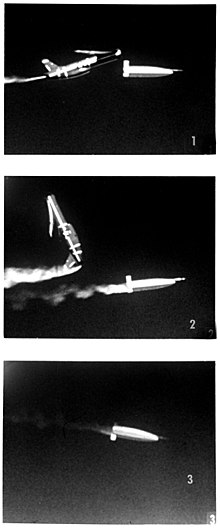SM-62 snark
| SM-62 snark | |
|---|---|
| General Information | |
| Type | Cruise missiles |
| NATO designation | SM-62A Snark, SSM-A-3 |
| Country of origin |
|
| Manufacturer | Northrop |
| development | 1946 |
| Commissioning | 1958 |
| Working time | 1958-1961 |
| Technical specifications | |
| length | 20.93 m |
| diameter | 1,400 mm |
| Combat weight | 22,500 kg |
| span | 12.86 m |
| Drive First stage Second stage |
2 solid fuel boosters with 580 kN each Pratt & Whitney J57-P-17 Turbojet with 51.1 kN |
| speed | Mach 0.94 |
| Range | 10,200 km |
| Service ceiling | 15,320 m |
| Furnishing | |
| steering | Inertial navigation platform and astronomical navigation |
| Warhead | W-39 nuclear warhead with 4.0 Mt |
| Weapon platforms | Floor-bound, ready for installation |
| Lists on the subject | |
The SM-62 Snark was a cruise missile used by the US Air Force between 1958 and 1961.
history
The Snark could carry a nuclear warhead over a distance of approximately 10,000 km. It was the only surface -to- surface cruise missile ever used by the US Air Force. The rapid development of ICBMs made further maintenance of the Snark superfluous in the early 1960s.
In 1951, the USAF introduced the model designation applicable to airplanes for guided missiles as well, since missiles were regarded as unmanned aircraft. So the Snark was renamed the B-62 . The XB-62 samples were used for performance testing designed to validate the basic design of the Snark. In 1955, the USAF changed its mind about aircraft classification and the B-62 was renamed the XSM-62. A planned reconnaissance variant XRB-62, which was later abandoned, was renamed XRSM-62.
technology
The Snark was started using two solid rockets. After the start-up phase, a Pratt & Whitney J57-P-17 turbojet engine took over. This engine was also used in the North American F-100 Super Saber , McDonnell F-101 Voodoo , Convair F-102 Delta Dagger and the Vought F-8U Crusader .
Due to the lack of a horizontal stabilizer, elevons were used. This led to an unusual flight pattern in which the nose of the missile pointed very high up. Shortly before the target, the warhead was separated from the missile. The warhead then continued to fly towards the target in a ballistic curve.
After its flight of up to 11 hours, the Snark could be landed and reused, provided the warhead was not separated from the missile. However, since there was no landing gear, a long, straight landing area was required on which the Snark could slide to a standstill. One runway at Cape Canaveral Air Force Station is still known as the "Skid Strip".
Whereabouts
- Air Force Space & Missile Museum , Cape Canaveral Air Force Station , Florida
- National Museum of the United States Air Force , Wright-Patterson Air Force Base , Dayton, Ohio
- Strategic Air and Space Museum , Ashland, Nebraska
- Hill Air Force Base , Ogden, Utah
- National Museum of Nuclear Science & History , Albuquerque, New Mexico
Web links
- Snark at the Federation of American Scientists (English)
- Snark in the Encyclopedia Astronautica (English)
- Snark at the National Museum of the USAF (English)
Individual evidence



